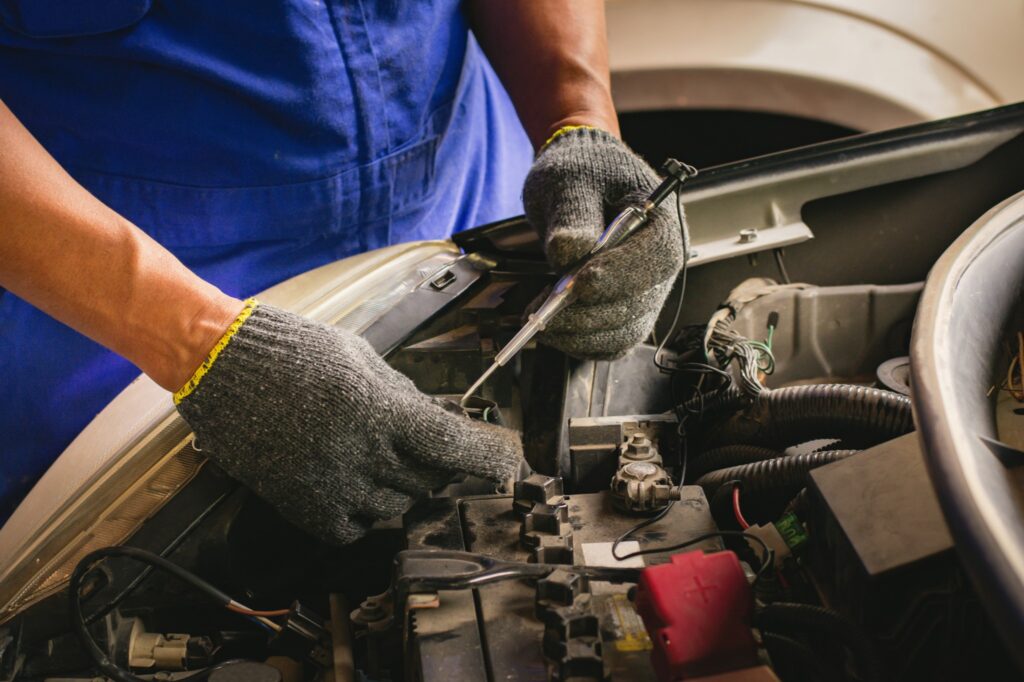Working on your vehicle can be dangerous, as you’re handling sharp, hot, and/or heavy tools and parts. If you’re not careful, you can get injured as you work. As such, it’s always best to err on the side of caution by wearing automotive gloves.
What Are Automotive Gloves?
Automotive gloves are usually made from thick and durable materials to protect the wearer’s hands from cuts and other possible injuries. Mechanics always wear them while doing repairs, especially when they’re going to handle sharp or hot components.
There are two types of gloves mechanics use. One is a thick variant to protect their hands from harsh work, including lifting engines, transmissions, and front-end work. The other type is rubber gloves to keep your hands clean and free from chemicals. Rubber tears easily, so they’re not used for protection.
Why Wear Automotive Gloves?
Some of the benefits of using automotive gloves include better hand protection, improved grip, callus prevention, and enhanced comfort.

Hand Protection
The most important reason why mechanics use automotive gloves is protection. Gloves are one of the most commonly used safety equipment, even in other professions.
When working with vehicles, you’re mostly using your hands to handle auto parts and tools. As such, you should protect them from scrapes, cuts, and other possible injuries.
Better Grip
Some procedures take several hours, so it’s natural to sweat. However, that could make it a struggle to maintain your grip on tools and parts.
Using gloves lets you get a better grip on any equipment and component, making it safer and easier to work on your daily driver. On top of that, these gloves make it easier to handle slippery parts, like those covered in oil or lubricant.
Prevents Calluses
Opting not to use gloves not only makes it harder to hold tools but also means your hands are more prone to developing calluses. After all, automotive gloves ensure you don’t make direct contact with tools and equipment, lowering the chances of getting callused hands.
Comfort
Most gloves are designed with functionality in mind, which is why some have gripping layers. However, some gloves also provide comfort, hence the different materials used to make them.
Nitrile gloves, for example, are made from soft and stretchable material to provide a comfortable fit.
Prevents Hand Prints
Another reason mechanics wear gloves is when they’re working on the interior and do not want to leave handprints and fingerprints, especially on the seats.
What Type of Gloves Do Mechanics Use?
Automotive gloves can be categorized based on their attributes and materials.
Attributes/Traits
There are gloves that are cut-resistant and heat-resistant. Some are also designed for winter use.
Cut-Resistant Gloves
As the name suggests, cut-resistant gloves protect your hands from wounds, especially when handling sharp tools and parts. These gloves are usually made from Kevlar.
Kevlar is a type of aramid fiber that’s also resistant to corrosion and heat. Kevlar is often used in aerospace engineering and other protective gear, like armor and bulletproof vests.
Heat-Resistant Gloves
Hot parts like the engine can burn skin, which is why many mechanics wear heat-resistant gloves. These gloves protect the hands from extremely high temperatures.
Silicone and asbestos are typically the main materials of heat-resistant gloves.
Winter Gloves
On the opposite side of the spectrum, winter gloves keep your hands warm to help you maintain a better grip. They’re also arguably the most versatile type of automotive gloves, as you can use them for construction, plumbing, or even outdoors during the winter.
There are several different materials used to make winter gloves, including wool or goatskin.
Materials
As for materials used, automotive gloves are typically made from latex, nitrile, and leather.
Latex
Latex is a precursor to vulcanized rubber and is the soft white substance beneath the bark of a rubber tree. It’s a natural elastic material used to make different items, such as bandages, toys, and automotive gloves.
Not only are they tear-resistant but they also conform to the hand, making them easy to wear. One downside of using latex gloves is they’re prone to holes from punctures.
Nitrile
Nitrile is a synthetic rubber copolymer of acrylonitrile and butadiene. It’s often used as an alternative by mechanics who are allergic to latex.
While nitriles don’t have the elasticity and flexibility of latex, they’re more durable and resistant to chemicals.These make nitrile gloves the perfect choice when handling corrosive chemicals, such as oil, gas, and grease.
Leather
Leather is made from animal skin, including pigs, sheep, goats, crocodiles, and commonly cows. They’re highly durable as a glove material, in addition to being heat and spark-resistant.
Leather automotive gloves also offer protection against cuts and burns while providing a good grip.
How to Pick a Good Automotive Glove
To pick a good automotive glove, you must consider thickness, durability, fit, grip, and comfort. If you have allergies to certain materials, make sure to take note of that as well.
Thickness and Durability
A thicker glove provides better protection against punctures and tears, making them more durable than other options. You also have to consider that thinner gloves could be more comfortable, especially during hotter temperatures.
Fit
Some gloves come in different sizes, as not everyone shares the same hand size. Picking a pair that perfectly fits is crucial, as it directly correlates with grip and comfort.
Grip
Using gloves that provide grip and dexterity can prevent possible injuries when working on your vehicle. As mentioned, some gloves have gripping layers on the fingers and palms to make it easier to hold and handle objects.
Price
You should also consider the cost since gloves vary in terms of price. Think of how long you’ll wear the gloves before changing. If you’ll only use it a couple of times, you can get away with cheaper ones. However, for longer use, it’s recommended to buy the pricier option to ensure durability.
Comfort
There are many repetitive movements in automotive work, so it’s best to maintain mobility. Choosing comfortable automotive gloves can help with that.
Besides fit, choose a pair of gloves made from materials you’re most comfortable with. If you can’t decide whether to get latex, nitrile, or leather gloves, test each material type. Determine what’s best for you.
Allergic Reactions
This mostly applies to latex gloves, as they can cause allergic reactions depending on the wearer. If your skin negatively reacts to the material, then nitrile might be better.
Nitrile gloves are available as powdered and non-powdered, with the former also causing the reaction in some people. If you have a bad reaction to powdered ones, it’s ideal to get the non-powdered version.
Any information provided on this Website is for informational purposes only and is not intended to replace consultation with a professional mechanic. The accuracy and timeliness of the information may change from the time of publication.


























